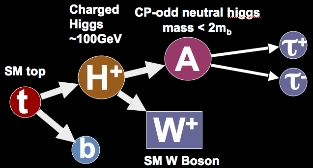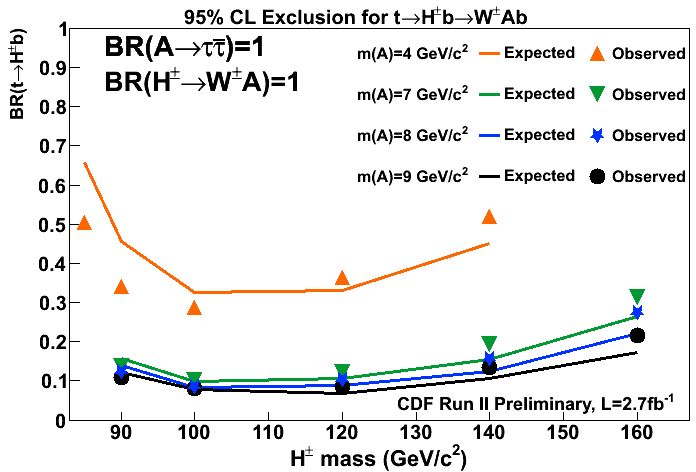I have no energy today to put together a detailed discussion of a brand new, exciting search for supersymmetric Higgs boson performed in data collected by the CDF experiment at the Tevatron proton-antiproton collider. All I can do for you is to show the interesting result of the search, and give you some very general ideas of what this is and why it is interesting. Maybe tomorrow or Saturday I will be able to pay more justice to the analysis.
So the search, performed in a total of 2.7 inverse femtobarns of collisions -that is about three hundred trillions of them- focuses on the fact that in a non-minimal scenario, Supersymmetry might give rise to not just five, but seven Higgs bosons. And some of them might be light and have still escaped detection so far: much lighter than the W and Z boson, in fact lighter than twice the mass of the b-quark. The LEP experiments have in truth excluded the existence of CP-odd Higgs bosons (called A particles) in a wide range of masses, but they could not reach down to masses below 9 GeV or so.
 The existence of several non-standard Higgs bosons, some of them light enough, would allow top quarks to decay in a as-of-yet untested way: a top could produce a b-quark and a charged Higgs; and the latter could decay into a W boson and a A Higgs boson. That very light Higgs particle would then decay into a pair of tau leptons, as shown in the diagram on the right, which I stole from the web page of the analysis, put together by the valiant authors and CDF colleagues R. Erbacher, A. Ivanov, and W. Johnson.
The existence of several non-standard Higgs bosons, some of them light enough, would allow top quarks to decay in a as-of-yet untested way: a top could produce a b-quark and a charged Higgs; and the latter could decay into a W boson and a A Higgs boson. That very light Higgs particle would then decay into a pair of tau leptons, as shown in the diagram on the right, which I stole from the web page of the analysis, put together by the valiant authors and CDF colleagues R. Erbacher, A. Ivanov, and W. Johnson.
The analysis is beautiful, but too long for me to discuss it here. Suffices, for today, to show below its results. In the figure you can see the limit on the branching fraction of the decay as a function of the charged Higgs boson mass. The limit that CDF is capable to set on the branching fraction depends on the mass of the A Higgs, and that is the reason of the family of bands: a heavier A boson would make it simpler to detect its decay products; the failure to observe the signal can then be converted into a stricter upper bound on the branching fraction.

The upper limits above, which for generality assume that all charged Higgs bosons decay into a W boson and a A boson, and that all A bosons decay into pairs of tau leptons, constitute the first experimental bound on the said process. If the A and H+ bosons exist, and the A has a mass of 7 to 9 GeV, the decay cannot be very frequent: not more than 10-15% of top decays may then produce charged Higgs bosons, or CDF would have seen them.
Kudos to the authors for this new interesting result! More information on the analysis may be found in the public web page of CDF the search.


